Southend Fire Brigade

Southend-on-Sea
When
the
local
board
was
formed,
the
only
fire
appliances
for
Southend
were
at
Rochford.
The
Board
inaugurated
Southend
fire
brigade
in
1875,
In
May
1877
a
shop
was
rented
in
Market
Place
just
off
Alexandra
Street
for
storing
the
awaiting
new
fire
engine.
In
September
1877
the
town’s
first
fire
engine
arrived,
it
was
a
second-hand
appliance
costing
£80.
It
was
met
by
a
procession
headed
by
the
town
band
and
taken
opposite
the
Ship
Hotel
where
there
were
fireworks
and
a
bonfire.
Volunteers
who
formed
the
new
fire
brigade,
Messrs.
Belcham,
Brewer,
Berry,
Storey,
Appleby
and
F.
J.
Woosnam,
were
given helmets, tunics and belts by the Board.
The
first
fire
the
brigade
attended
was
at
Young’s
shop
opposite
the
post
office
in
the
High
Street,
in
March
1887.
The
horses
to
draw
the
engine
were
kept
at
Scott’s
stables
and
when
a
fire
occurred
at
Stambridge
Mills
in
1878,
a
man
was
sent
to
Rochford
post
office
where
a
message
was
telegraphed
to
Southend
post
office
who
got
in
touch
with
the
fire
brigade.
The
firemen
got
to
the
fire
just
within
forty
five
minutes
later,
which
was
good
going
in
those
days,
and
although
there
was
a
terrific
blaze,
they
were
able
to
save
a
large part of the mills.
In
1891
the
first
electric
call
system
was
installed,
but
difficulty
of
communications
in
was still a problem.
On
2nd
of
October
1892,
a
great
fire
started
in
Leigh
old
town.
By
this
time
the
town
had
a
new
steam
fire
engine,
bought
by
subscription
called
“The
Alert.”
The
fire
started
at
the
Peter
Boat
when
a
lamp
overturned.
The
fire
practically
destroyed
the
Peter
Boat,
the
Red House and Carey’s house was badly damaged.
The
Fire
Station,
Tylers
Avenue,
opened
on
15th
October
1902;
its
erection
having
cost
£3,500.
The
Main
building
was
a
red
brick
building
of
striking
elevation,
comprising
of
accommodation
for
the
engines
and
escapes
on
the
first
floor,
with
men’s
recreation
room,
kitchen,
and
sleeping
quarters
on
the
second,
There
were
two
steam
fire
engines
always
ready
for
service
and
manned
by
volunteers.
In
1908
the
local
brigade
won
the
national
shield
for
steamer
drill
at
the
annual
meeting
of
the
National
Fire
Brigade
Union at Scarborough.
Southend Timeline Southend-on-Sea © 2009 - 2024. All Rights Reserved
Fire fighting near Francis & Sons Printers on
the High Street, Southend
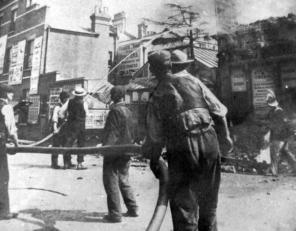
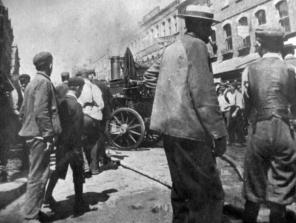
Fire fighting, using a steam appliance in
Southend
c1909 Southend Fire Station, Tylers Avenue, Southend
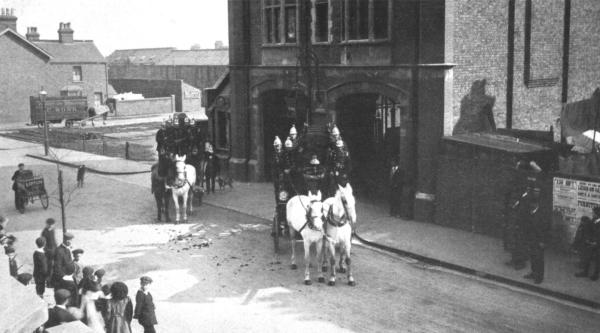
Southend Central Fire Station,
Sutton Road, Southend-on-Sea
25th
September
1964:
Southend
Central
Fire
Station
in
Sutton
Road
opened.
Mr
H.
M.
Smith
CBE
MIFireE,
Her
Majesty's
Chief
Inspector
of
Fire
Services
performed
the
official
opening
ceremony.
The
ceremony
included
a
full
drill
of
the
Southend
Fire
personnel
accompanied
by
the
Band
of
the
London
Fire
Brigade.
The Official Opening Ceremony;
2:50pm:
Her
Majesty's
Chief
Inspector
of
Fire
Services
Mr
H.
M.
Smith,
Official Party and Guests will arrive at the Central Fire brigade Station.
His
Worship
the
mayor
will
call
upon
the
Chairman
of
the
Fire
Brigade
Sub-
committee
Alderman
Norman
Clarke,
to
invite
Her
Majesty's
Chief
Inspector
to unveil a commemorative plaque in the station vestibule.
Official Party will be conducted to dais in the drill area.
The
Mayor
will
welcome
Mr
H.
M.
Smith
and
request
him
to
formally
declare
the
Fire
Brigade
Station
open.
The Chairman of the Fire brigade Sub-Committee will move a vote of thanks.
Display by members of the Fire Brigade with their appliances.
God save the Queen.
Arrangements will be announced for the inspection of the Fire brigade Station.
Music by the Band of the London Fire Brigade.
Leigh Fire Station,
Mountdale Gardens, Leigh-on-Sea
28th
March
1969:
Leigh
Fire
Station
in
Mountdale
Gardens,
Leigh-on-Sea,
was
formally
opened
by
Mr
A.
J.
Frame
MBE,
Her
Majesty's
Inspector
of
Fire
Services.
The
site
was
formally
the
18th-19th
century
Brickhouse
Farm.
A
location
that
was
deemed
suitable
for
preservation
in
1961,
but
was
turned
down.
This
long
awaited
modern
fire
station
would
serve
the
west
side
of
the
borough
replacing
the
old
fire
station
in
Elm
Road.
The
first
Leigh
Fire
Station
was
built
as
part
of
the
old
Urban
District
Council
Offices
scheme,
and
opened
in
May
1912.
It
had
accommodation
on
the
ground
floor
for
combined
fire
engine
and
escape,
and
above
was
a
spacious
recreation
room,
with caretaker’s quarters.
The Official Opening Ceremony;
2:50pm:
Her
majesty's
Inspector
of
Fire
Services
Mr
A.
J.
Frame,
Official
party and Guests will arrive at the Leigh Fire Station.
His
Worship
the
Mayor
will
call
upon
the
Chairman
of
the
Fire
and
Public
Supervisory
Services
Committee
Alderman
Norman
Clarke
to
invite
her
Majesty's
Inspector
to
unveil a commemorative plaque in the station Entrance Hall.
Official party will be conducted to the dais in the drill area.
The
mayor
will
welcome
Mr
A.
J.
Frame
and
request
him
to
formally
declare
the
Fire
Station Open.
Mr A. J. Frame will declare the Fire Station open.
The
Chairman
of
the
Fire
and
Public
Supervisory
Services
Committee
will
move
a
vote
of thanks.
Display by members of the Fire Brigade with their appliances.
God save the Queen.
Arrangements will be announced for the inspection of the Fire Station.
Music by the Band of the London Fire Brigade.
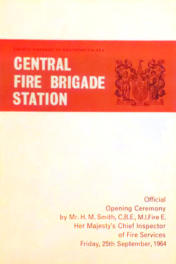
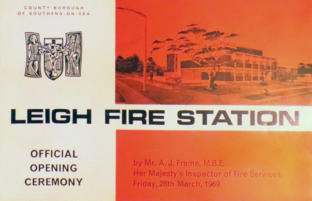
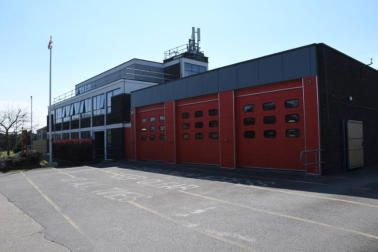
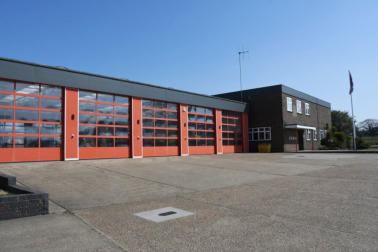
2021 Leigh Fire Station, Mountdale Gardens
2021 Southend Fire Station, Sutton Road
Southend Fire Station
official opening brochure
Leigh Fire Station official opening brochure
National Fire Service
With
the
introduction
of
the
Fire
Brigades
Act
of
1938
this
made
the
county
boroughs,
urban
districts
and
rural
districts
each
responsible
for
their
own
provision
of
an
adequate
and
efficient
fire
service.
With
war
looming
a
major
study
was
undertaken
into
the
services
being
provided,
this
resulted
in
the
Home
Secretary
establishing
a
National
Fire
Service
in
May
1941,
this
was
achieved
by
amalgamating the Auxiliary Fire Service and the fire services operated by the local authorities.
The
scrapping
of
the
local
fire
services,
the
country
was
divided
into
separate
regions,
a
central
Home
Office
Fire
Control
was
established
in
London
to
maintain
contact
with
each
of
the
regional
organisations,
this
would
also
enable
better
communication
between
regions
should
extra
help
be
needed
during
or
after
an
air
raid.
Each
area
was
given
a
number,
Southend
was
designated
Area
11.
1/
Gosforth.
2/Middlesbrough.
3/
Rotherham.
4/
Leeds.
5/
Bradford.
6/
Hessle.
7/
Derby.
8/
Nottingham.
9/
Leicester.
10/
Louth.
11/
Southend.
12/
Stevenage.
13/
Hethersett.
14/
Durley.
15/
Taplow.
16/
Lyndhurst.
17/
Bristol.
18/
Exeter.
19/
Yelverton.
20/
Llanishen.
21/
Sketty.
22/
Colwyn
Bay.
23/
Worcester.
24/
Birmingham.
25/
Stone.
26/
Liverpool.
27/
Cheadle.
28/
Bolton.
29/
Preston.
30/
Maidstone.
31/
Brighton.
32/
Woking
33/
London
(Administrative).
34/
London
(Ealing).
35/
London
(Highgate).
36/
London
(Ilford).
37/
London
(Eltham).
38/
London
(Wimbledon).
39/
Swindon.
40/
Wolverhampton.
41/
Warrington.
42/
Stalybridge. 43/ Kendal.
The
NFS
was
manned
by
both
full
time
and
part
time
crews,
these
were
made
up
of
men
and
women,
men
would
work
every
fourth
night,
women
every
sixth
night.
When
on
duty
crews
were
able
to
volunteer
to
be
involved
in
manufacturing
for
the
war
effort,
with
a
small
part
of
the
fire
station
given
over
to
the
job,
fire-fighters
could
also
work
in
buildings
alongside
the
fire
station,
most
would
offer to take up the task as many had previously worked in factories before the war.
Service
in
the
NFS
would
mean
putting
yourself
at
very
considerable
risk,
as
the
NFS
would
be
called
out
to
attend
not
only
the
aftermath
of
the
German
air
raids,
but
also
much
of
the
time
attend
fires
as
the
air
raids
were
still
ongoing.
The
fires
would
make
buildings collapse and unexploded bombs could go off at any time or bomb could drop onto the site they were working.
The
highest
number
of
people
working
for
the
NFS
was
370,000
of
which
80,000
were
women
who
were
mostly
employed
on
administrative roles, however some would be front-line team members going out to tackle fires.
The
NFS
was
disbanded
in
1948,
when
the
local
authorities
once
again
took
charge,
however,
the
number
was
slashed
from
the
previous
1600
before
the
war,
this
was
because
each
County
Council
was
responsible
for
the
operation
of
the
services
within
that
county,
County
Borough’s
such
as
Southend
retained
control
of
their
own
fire
service
operations.
Eventually
the
Borough
Fire
Services were absorbed into the county fire services



Southend-on-Sea’s No 1 History Website! Documenting The Town & The Townspeople

Now Incorporating The Sea Of Change Website
Website Info:


Chalkwell ▪ Eastwood ▪ Leigh-on-Sea ▪ Prittlewell ▪ Shoeburyness ▪ Southchurch ▪ Thorpe Bay ▪ Westcliff-on-Sea
SOUTHEND CITY
































































